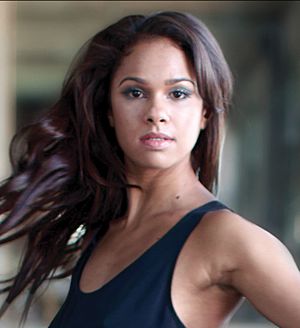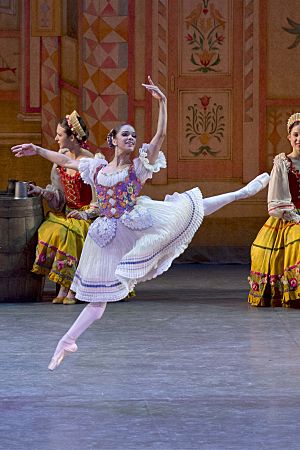Misty Copeland facts for kids
Quick facts for kids
Misty Copeland
|
|
|---|---|

Copeland in 2013
|
|
| Born |
Misty Danielle Copeland
September 10, 1982 Kansas City, Missouri, U.S.
|
| Education | San Pedro High School |
| Occupation | Ballet dancer |
| Years active | 1995–present |
| Spouse(s) |
Olu Evans
(m. 2016) |
| Children | 1 |
| Relatives | Taye Diggs (cousin-in-law) |
| Current group | American Ballet Theatre |
Misty Danielle Copeland (born September 10, 1982) is an amazing ballet dancer. She dances for the American Ballet Theatre (ABT), which is one of the top ballet companies in the United States. On June 30, 2015, Misty made history. She became the first African American woman to be promoted to a principal dancer in ABT's 75-year history. This means she became one of the main, most important dancers in the company!
Contents
Early Life
Misty Copeland was born in Kansas City, Missouri. She grew up in San Pedro, a community in Los Angeles, California. Her dad has German and African American roots. Her mom has Italian and African American ancestry.
Misty is the youngest of four children from her mother's second marriage. She also has two younger half-siblings. Her mother used to be a cheerleader for the Kansas City Chiefs. She had also studied dance.
Misty didn't formally study ballet or gymnastics when she was little. She started later, in her teenage years. She became the captain of her middle school's drill team. Her coach, Elizabeth Cantine, noticed Misty's natural grace.
Discovering Ballet
In early 1996, her coach, Elizabeth Cantine, suggested Misty try a ballet class. The class was at her local Boys & Girls Club. Cynthia Bradley, a friend of Cantine's, taught a free ballet class there once a week. Misty watched a few classes before she decided to join in. Her mom let her go to the club after school.
Soon, Cynthia Bradley invited Misty to her own ballet school, the San Pedro Dance Center. Misty first said no. She needed to help her mom take care of her siblings. But Cynthia Bradley started picking her up from school. So, Misty began her ballet studies at age 13. After only three months, she was dancing en pointe. This means she was dancing on the tips of her toes!
Misty thought about quitting ballet. The school was far from her home. But Bradley wanted Misty to keep dancing. She offered for Misty to live with her family. Misty then spent most of the next three years living with the Bradleys.
A Rising Star
Misty Copeland was seen as a prodigy. This means she was incredibly talented at a young age. By age fourteen, Misty won a national ballet contest. She also got her first solo role. She loved to read about ballet and watch videos of dancers.
After only eight months of training, she performed as Clara in The Nutcracker. This was at San Pedro High School. Her amazing talent quickly got attention from the media.
She later played a bigger role as Kitri in Don Quixote. This was at the San Pedro Dance Center. She also performed in The Chocolate Nutcracker. This was an African American version of the famous tale. Debbie Allen narrated it. Misty's role in this show was changed just for her. It included special ethnic dances.
Misty's ballet teacher, Cynthia Bradley, gave her intense training. Bradley's husband, a modern-dance teacher, also helped Misty. He taught her pas-de-deux, which means dancing with a partner. He was also her dance partner. Before her fifteenth birthday, Bradley started homeschooling Misty. This gave Misty more time to dance.
When she was fifteen, Misty won first place in the Los Angeles Music Center Spotlight Awards. This was in March 1998. She received a scholarship. The Los Angeles Times newspaper called her the best young dancer in the Greater Los Angeles Area.
Challenges and Triumphs
After a while, Misty returned to her mother's home. They had disagreements. Her mother decided Misty would stop studying with the Bradleys. Misty was very upset. She was afraid she wouldn't be able to dance anymore. She wanted to be independent so she could keep dancing.
In 1998, her ballet teachers and her mother had a disagreement about who Misty would live with. Both sides eventually stopped the legal process. Misty moved back home. She began studying with a new teacher. This teacher used to be a dancer with ABT.
Misty attended two summer workshops with ABT. In 2000, she joined ABT's Studio Company. In 2001, she became part of its corps de ballet. This is the group of dancers who perform together. By 2007, she became an ABT soloist.
Becoming a Principal Dancer

Misty Copeland was the only black woman in the ABT company for a long time. She sometimes felt alone because of this. The artistic director of ABT, Kevin McKenzie, noticed this. He asked Susan Fales-Hill to mentor Misty. Fales-Hill introduced Misty to other successful black women. They encouraged Misty and helped her feel stronger.
Misty became a soloist at ABT in August 2007. She was one of the youngest dancers to become a soloist at ABT.
For most of her career at ABT, Misty was the only African-American woman in the dance company. The ballet world often lacks diversity. Because she was an African American ballerina, she sometimes felt isolated. People have even compared her to Jackie Robinson. He was a famous baseball player who broke barriers.
On June 30, 2015, Misty Copeland made history again. She became the first African-American woman to be promoted to principal ballerina in ABT's 75-year history. This was a huge achievement! Very few African-American principal ballerinas have danced at major companies.
In 2017, she performed as a guest dancer with La Scala Theatre Ballet. This was when they visited Southern California.
Life Outside Ballet
Misty Copeland and her husband, Olu Evans, live in New York City. Olu is an attorney. His cousin, Taye Diggs, introduced them around 2004. They announced their engagement in 2015. They got married in California on July 31, 2016. They have one child, a son, who was born in 2022.
Cool Facts About Misty
- Misty never formally studied ballet or gymnastics until she was a teenager. But when she was young, she loved making up dances to Mariah Carey songs!
- When she was seven, she watched the movie Nadia on TV. The gymnast Nadia Comăneci became her new role model.
- She started to look up to Paloma Herrera, a principal ballerina with ABT. Misty saw her perform and admired her as much as Mariah Carey.
- In March 2009, Misty filmed a music video with the musician Prince. It was for his cover of "Crimson and Clover".
- She started taking acting lessons in 2009.
- Besides dancing, Misty is also a public speaker and a celebrity spokesperson. She performs on stage too.
- She has written two books about her life. She also narrated a documentary about her career challenges called A Ballerina's Tale.
- In 2011, she was on the Hulu web series A Day in the Life.
- Misty was a guest judge for the 11th season of FOX's So You Think You Can Dance.
- She released her memoir, Life in Motion: An Unlikely Ballerina, in 2014. It was co-written with Charisse Jones.
- Her children's picture book, Firebird, came out in 2014. It has a message of strength for young people of color. She released another children's book, Bunheads, in 2020.
- She performed on Broadway in the musical On the Town. She also toured as a dancer for Prince.
- Misty was included in the 2015 International Best Dressed List by Vanity Fair.
- In 2017, Misty released the book Ballerina Body. It is a guide about health and fitness.
- Misty dances the lead ballerina role in the 2018 Disney movie, The Nutcracker and the Four Realms. This movie is based on the famous story "The Nutcracker and the Mouse King".
- She has promoted products for companies like T-Mobile, Coach, Inc., Dr Pepper, Seiko, The Dannon Company and Under Armour.
- In 2015, Misty appeared on the cover of Time magazine. She was the first dancer to be on the cover since 1994!
- Misty enjoys cooking.
- In 2016, Mattel created a Misty Copeland Barbie doll.
- In 2024, a silent documentary called "Flower" was shown at the Bentonville Film Festival. Misty Copeland was featured in it.
Inspiring Words
- “I knew that I just didn't have it in me to give up, even if I sometimes felt like a fool for continuing to believe.”
- “Start unknown, finish unforgettable.”
- “I may not be there yet, but I am closer than I was yesterday.”
- “Knowing that it has never been done before makes me want to fight even harder.”
- “Decide what you want. Declare it to the world. See yourself winning. And remember that if you are persistent as well as patient, you can get whatever you seek.”
- “Don’t underestimate yourself. You are more capable than you think.”
Awards and Recognition
- In 2008, Misty won the Leonore Annenberg Fellowship in the Arts. This award helps dancers study with master teachers.
- In 2013, she was named National Youth of the Year Ambassador. This was by the Boys & Girls Clubs of America.
- In 2014, Misty was named to the President's Council on Fitness, Sports, and Nutrition. She also received an honorary doctorate from the University of Hartford. This was for her contributions to ballet and helping to make it more diverse.
- Misty Copeland was honored with a Dance Magazine Award in 2014.
- After she became a principal dancer, Glamour magazine named her one of their Women of the Year for 2015. ESPN also named her one of their 2015 Impact 25 athletes. These are influencers who made a big impact for women in sports.
- In 2016, Misty won a Shorty Award for Best in Dance on Social Media.
- In 2021, the NAACP gave Misty Copeland its highest honor, the Spingarn Medal.
- On May 17, 2023, Misty received an honorary Doctor of Fine Arts degree from New York University.
Images for kids
See also
 In Spanish: Misty Copeland para niños
In Spanish: Misty Copeland para niños
- List of dancers







